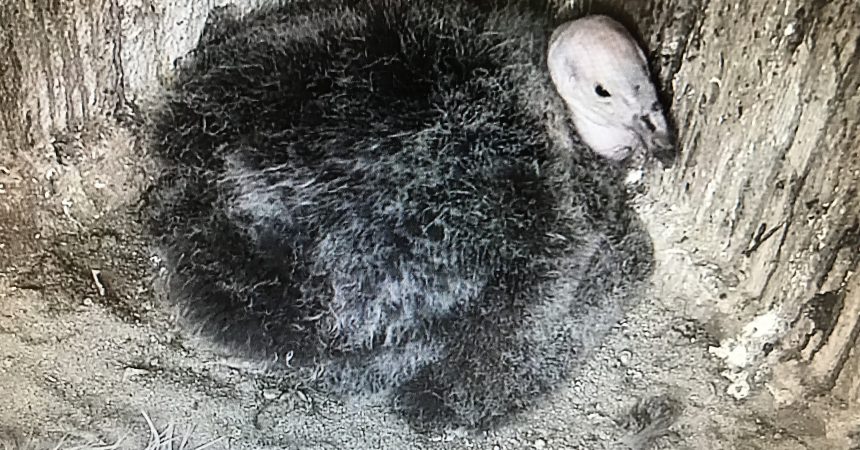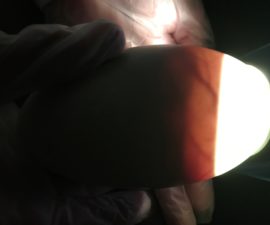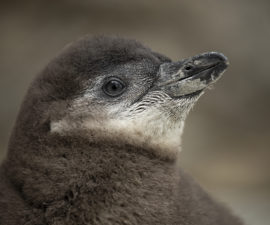On Tuesday, May 15, our California condor chick, named Kitwon (pronounced “KEET-won”), received its first health exam. We normally conduct this exam at around 45 days of age. The goal was to obtain a blood sample for our labs, administer a vaccine for West Nile virus, inject a microchip for identification, and weigh the chick.
The first step in this process is to separate the parents from the chick. Of course, the parents—father Sisquoc and mother Shatash—don’t want any invaders in the nest and do their best to defend the chick and keep it safe, as all good parents will do. Adjacent to the flight pen, we have a shift pen. Shift pens are used to safely and calmly move large or dangerous animals from one area to another. Other animals at the Safari Park that are moved with shift pens are lions, gorillas, and bighorn sheep, among others. That’s why you never see any keepers in the exhibits at the same time with these animals. We offer all of the condors’ diet in the shift pen, so Sisquoc and Shatash are very comfortable entering the shift pen for every meal. We shifted Sisquoc into the pen and kept him there until after the exam. From his shift pen, he cannot see the nest area, so he was unaware that we were even in his nest, thus keeping him very calm. He ate and waited patiently until he had access back into his flight pen.
Shatash was not shifted, but instead was able to see us go into her nest. We posted one keeper in the nest entryway to keep Shatash out, while another keeper secretly entered the nest and covered the little chick with a towel. This is the first time that the 46-day-old chick had ever seen a person, and was understandably—and expectedly—nervous and defensive, hissing and lunging at the intruder. Once under the cover of the towel, the chick could not see and calmed down. It was then brought downstairs to our keeper area where our veterinary staff was waiting.
First, the veterinarian obtained a blood sample from the chick’s leg. This sample will be sent to the lab to make sure that the chick is healthy. Also, our geneticists at the San Diego Zoo Institute for Conservation Research can determine if Kitwon is male or female from this sample.
Next, a vaccine for West Nile virus was administered. West Nile virus is a disease that originated in Africa and was accidentally introduced to North America by humans. North American animals, including condors, usually don’t have a natural immune response to West Nile Virus, so we are trying to give the chicks as much of a head start as we can.
Then a microchip was injected under the chick’s skin. This chip hold identification information. It’s the same kind of chip you can get for your dog or cat at your vet’s office.
The veterinarian then gave a quick health assessment, checking the chick’s eyes, nares (nostrils), beak, feet, legs, wings, and abdomen.
Lastly, we weighed the chick to make sure it was growing on schedule.
While the exam took place, a third keeper was able to enter the nest to clean the camera domes and make sure there were no hazards in the nest cavity. The whole exam, from capture to release, took approximately 15 minutes.
Once the exam was over, Kitwon was returned to the nest and Shatash was allowed to approach and check on her baby. As previously mentioned, the chick was rightfully disturbed by this process, despite our best intentions to minimize stress. Although we feel bad that the chick was so nervous, it is actually good that it was not comfortable in our presence. We have to keep in mind that we don’t want the young condor to become accustomed to or feel reassured by humans; we want it to be a wild condor, uninterested and wary of humans, so that it may someday fly free in California, Arizona, or Mexico. Condors that show an affinity for humans seldom survive in the wild. Shatash peeked into the nest, but did not enter. Once she saw her chick was okay, she perched in the flight pen near the nest. With everyone appearing calmer, Sisquoc was let out of his shift pen. A few minutes after that, he entered the nest to investigate. After about 50 minutes, the chick began wing-begging and he fed it.
So far, the health exam looks to have been successful. Hopefully, the blood work will show that the chick is healthy. The veterinarian’s initial inspection looked great; the chick’s eyes and nares were clear, the feet, legs and wings were solid, and vitality was very strong. The chick weighed 8 pounds 2.5 ounces (3.70 kilograms) and was approximately the size of a bowling ball. We hope to receive the sex results from the Conservation Genetics Lab soon. When we do, we’ll let you know if Kitwon is a male or a female.
Ron Webb is a senior keeper at the San Diego Zoo Safari Park. Read his previous blog, California Condor Chick Watching: 1 Week to 1 Month of Age.





